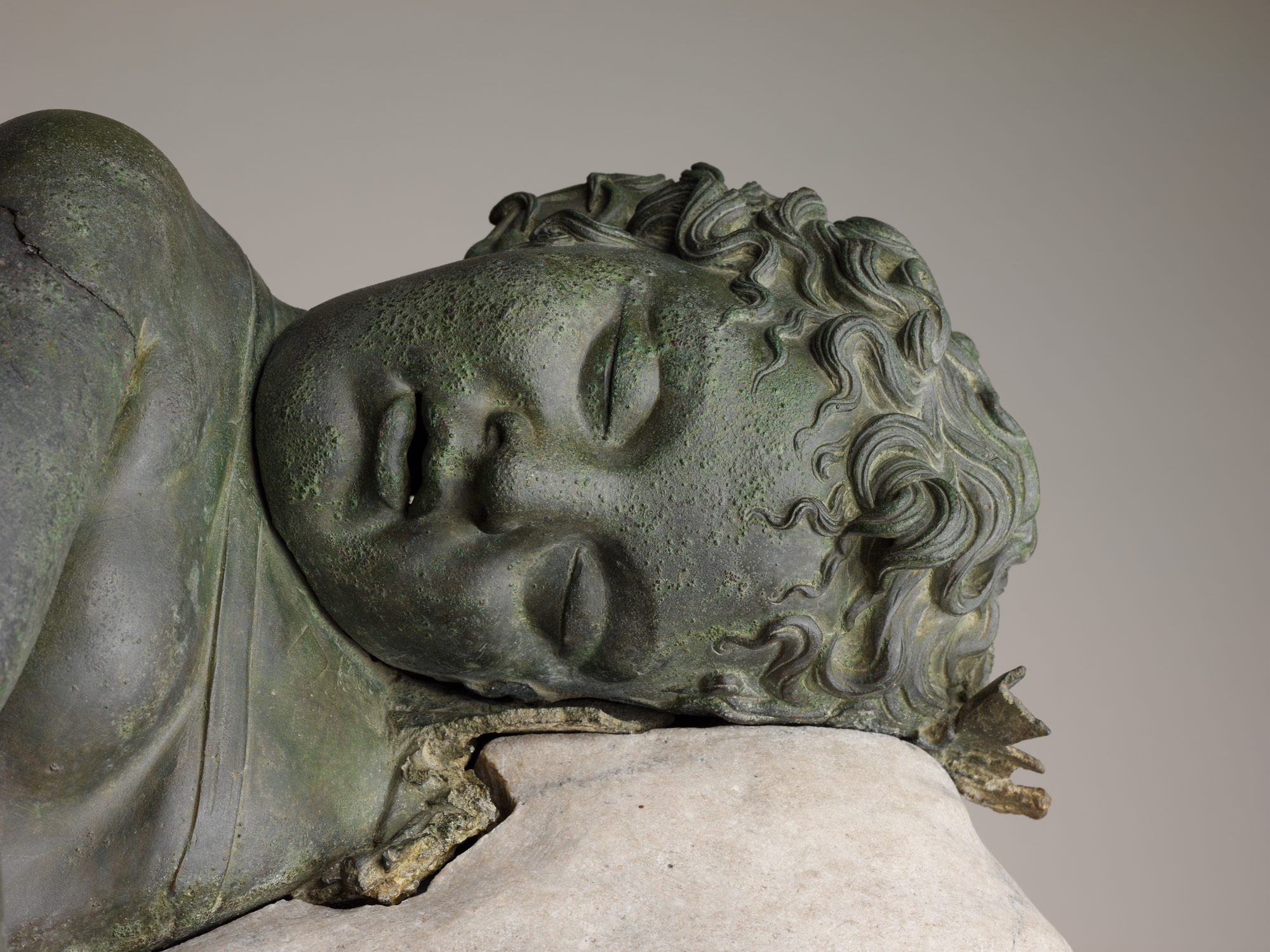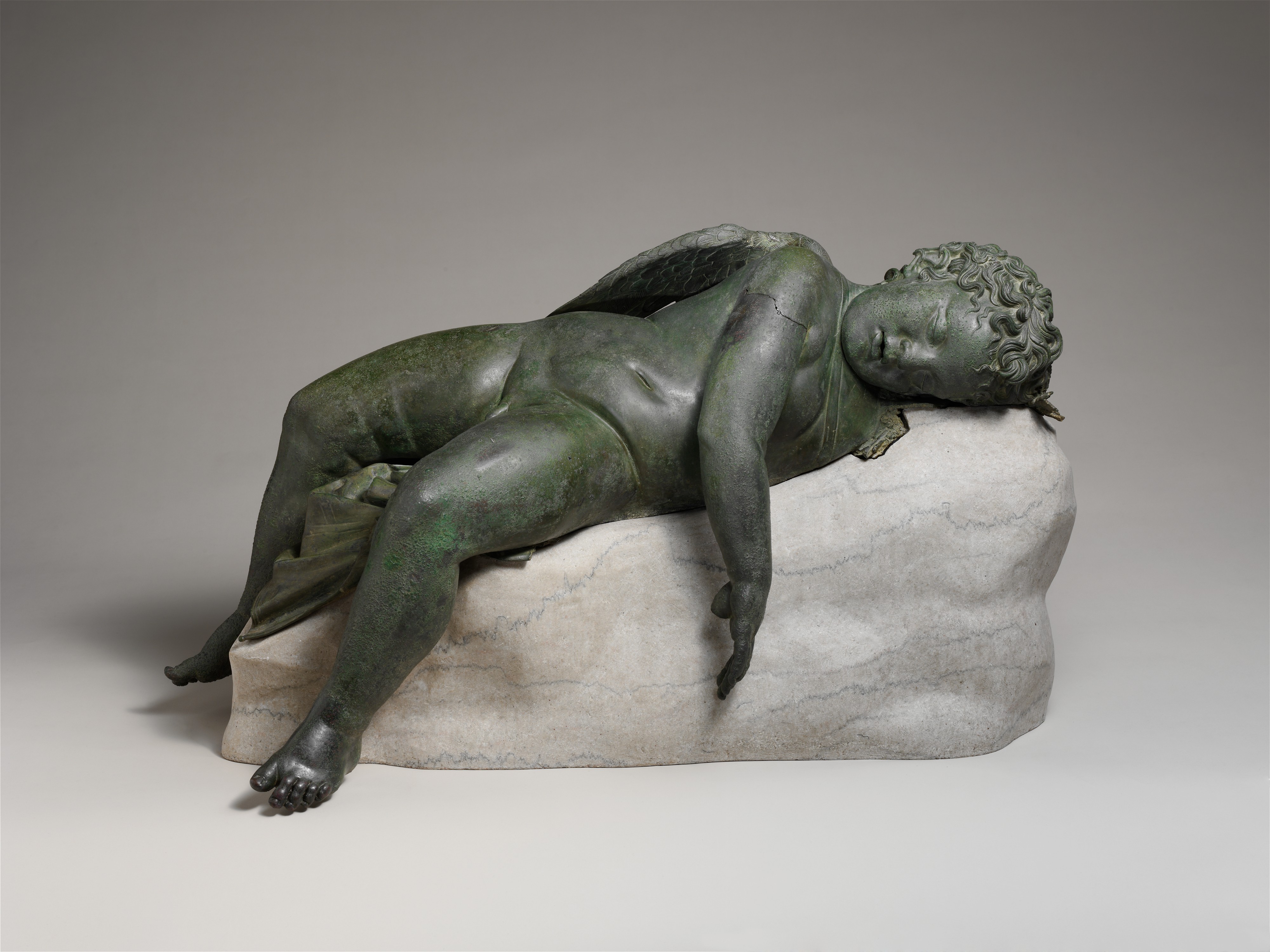Bronze statue of Eros sleeping

This is known as the, Bronze statue of Eros Sleeping, from the 3rd century B.C.-early 1st century A.D.; Hellenistic period. This bronze statue of Eros, is unlike any other statues of Gods, as Gods are often portrayed as heroic, with dynamic poses. Here we see Eros a primeval God the son of Chaos, as an infant, different from past sculptures. As Eros the God of love, desire, and sexual love, is often characterized as youthful, cruel and careless with his abilities that make others fall in love. But in this seven piece statue, made up of the head, arms, legs, wings, body, and drapery. Eros is seen as a sleeping babe, showing the purity, and innocence of love. As in the statue we can see the sincerity and calmness shown through his chubby body, through the flaps of skin overlapping; giving a feeling of naturalism throughout the piece.
Being seen as a harmless babe, people might think Eros is Cupid, except Eros is a Greek God, while Cupid was based off of Eros, with Cupid being a Roman god. When I see this photo of sleeping Eros I can feel the sincerity and innocence within it as the chubby features of his body. Which amazes me, I can only imagine, what it feels like to see the real statue of Eros sleeping.

Here in this photo bellow, it shows how Eros is usually depicted, as a youthful God; but seeing this image, of Eros I can sense his careless presence. Different than the photo above giving a sort of harmonious feeling.
Art, The Metropolitan Museum of, and The Metropolitan Museum of Art. Bronze Statue of Eros Sleeping. smarthistory.org/bronze-statue-of-eros-sleeping/.
Cartwright, Mark. Eros. 8 Sept. 2020, www.ancient.eu/Eros/.


It's been interesting to see the transformation of the Ancient Greek art unfold in this class. We started out seeing very stoic figures expressing heroic deeds. Then, as time progressed, the artists began showing vulnerability in the subjects. I love how Eros is depicted as a sweet little sleeping child but is a God. I read somewhere that the bronze medium is actually what allowed the Greeks to get more fluid and naturalistic with their subjects. Until this class, I never knew that bronze was how these statues were originally presented. This was a nicely written, and I love how you included a comparison picture.
ReplyDeleteThe first picture of this blog post really caught my eye. As you mentioned, most Greek art is heroic. However, this specific statue portrays innocence. I like how you picked such a unique piece of artwork from this time period because it shows that the Greeks were much more than just competition, war, etc. You did a good job explaining the meaning of this piece.
ReplyDeleteThe second picture you posted portrays him more as "youthful, cruel and careless" like you mentioned. However, the first picture, portrays the opposite of what I would imagine the son of the God of Chaos. You did a wonderful job giving detail!
ReplyDeleteIt's always so interesting to learn more about the ancient gods and the way people of the time portrayed them, especially when their power over us humans is as interesting as Eros'. One who could ruin the entirety of the planet with the power of love and lust no less. Overall great post!
ReplyDeleteHi David, This is an interesting piece of artwork to bring to topic and I’m glad you did. The fact that the artist(s) chose to display a God as a baby is an interesting choice. Especially when that God is a son of chaos and God of love, desire, and sexual love. Do you know why the artist chose to portray Eros as an infant?
ReplyDeleteHey David!
ReplyDeleteI enjoyed reading your blog post regarding Ancient Greece, the Hellenistic period and the bronze statue of Eros sleeping. A few things that worked well in your blog was including the photograph of your piece in the beginning, including dates of importance in relation to the time period, and explaining who Eros was and his significance with Ancient Greek culture and beliefs.
-Autumn Fink